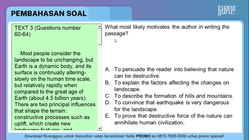Iklan
Pertanyaan
TEXT 3 (Questions number 60-64)
Most people consider the landscape to be unchanging, but Earth is a dynamic body, and its surface is continually altering-slowly on the human time scale, but relatively rapidly when compared to the great age of Earth (about 4.5 billion years). There are two principal influences that shape the terrain: constructive processes such as uplift, which create new landscape features, and destructive forces such as erosion, which gradually wear away exposed landforms.
Hills and mountains are often regarded as the epitome of permanence, successfully resisting the destructive forces of nature, but in fact they tend to be relatively short-lived in geological terms. As a general rule, the higher a mountain is, the more recently it was formed. Lower mountains tend to be older and are often the eroded relics of much higher mountain chains.
The Earth's crust is thought to be divided into huge, movable segments, called plates, which float on a soft plastic layer of rock. Some mountains were formed as a result of these plates crashing into each other and forcing up the rock at the plate margins. In this process, sedimentary rocks that originally formed on the seabed may be folded upwards to altitudes of more than 26,000 feet. Other mountains may be raised by earthquakes, which fracture the Earth's crust and can displace enough rock to produce block mountains. A third type of mountain may be formed as a result of volcanic activity which occurs in regions of active fold mountain belts.
Whatever the reason for mountain formation, as soon as land rises above sea level it is subjected to destructive forces. The exposed rocks are attacked by the various weather processes and gradually broken down into fragments, which are then carried away and later deposited as sediments. Thus, any landscape represents only a temporary stage in the continuous battle between the forces of uplift and those of erosion.
The weather, in its many forms, is the main agent of erosion. Rain washes away loose soil and penetrate cracks in the rocks. Carbon dioxide in the air reacts with the rain water, forming a weak acid (carbonic acid) that may chemically attack the rocks. The rain seeps underground and the water may reappear later as springs. These springs are the sources of streams and river which cut through the rocks and carry away debris from the mountains to the lowlands. Under very cold conditions, rock can be shattered by ice and frost. Glaciers may form a permanently cold area, and these slowly moving masses of ice cut out valleys, carrying with them huge quantities of eroded rock debris. In dry areas, wind is the principal agent of erosion. It carries fine particles of sand, which bombard exposed rock surfaces, thereby wearing them into yet more sand.
64. What most likely motivates the author in writing the passage?
64. What most likely motivates the author in writing the passage?
To persuade the reader into believing that nature can be destructive.
To explain the factors affecting the changes on landscape
To describe the formation of hills and mountains
To convince that earthquake is very dangerous for the landscape
To prove that destructive force of the nature can annihilate human civilization
Iklan
N. Puspita
Master Teacher
1
0.0 (0 rating)
Iklan
Pertanyaan serupa
RUANGGURU HQ
Jl. Dr. Saharjo No.161, Manggarai Selatan, Tebet, Kota Jakarta Selatan, Daerah Khusus Ibukota Jakarta 12860
Produk Ruangguru
Bantuan & Panduan
Hubungi Kami
©2025 Ruangguru. All Rights Reserved PT. Ruang Raya Indonesia

















